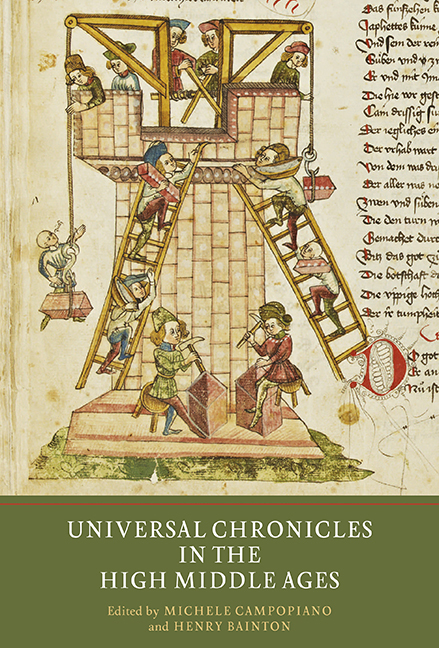Book contents
- Frontmatter
- Contents
- List of Illustrations
- Dedication
- Contributors
- Introduction: New Perspectives on Universal Chronicles in the High Middle Ages
- 1 The First Islamic Chronicle: The Chronicle Of Khalīfa B. Khayyāṭ (d. AD 854)
- 2 Universal Historiography as Process? Shaping Monastic Memories in the Eleventh-Century Chronicle Of Saint-Vaast
- 3 Writing Universal History in Eleventh-Century England: Cotton Tiberius B. i, German Imperial History-writing and Vernacular Lay Literacy
- 4 Political Didacticism in the Twelfth Century: the Middle-High German Kaiserchronik
- 5 Cosmology, Theology of History and Ideology in Godfrey of Viterbo's Pantheon
- 6 Écrire l'histoire universelle à la cour de Konrad IV de Hohenstaufen : la Weltchronik de Rudolf von Ems (milieu du XIIIe siècle)
- 7 Écrire la première histoire universelle en français: l'Histoire ancienne jusqu’à César de Wauchier de Denain et l'adaptation du modèle latin de l'histoire universelle à un public de laïcs
- 8 How Unusual was Matthew Paris? The Writing of Universal History in Angevin England
- 9 The Pillars of Hercules: The Estoria De Espanna (Escorial, Y.I.2) as Universal Chronicle
- 10 La vie d'Alexandre dans la Chronique dite de Baudouin d'Avesnes
- 11 Universal Histories and their Geographies: Navigating the Maps and Texts of Higden's Polychronicon
- Index
- Writing History in the Middle Ages
11 - Universal Histories and their Geographies: Navigating the Maps and Texts of Higden's Polychronicon
Published online by Cambridge University Press: 23 June 2018
- Frontmatter
- Contents
- List of Illustrations
- Dedication
- Contributors
- Introduction: New Perspectives on Universal Chronicles in the High Middle Ages
- 1 The First Islamic Chronicle: The Chronicle Of Khalīfa B. Khayyāṭ (d. AD 854)
- 2 Universal Historiography as Process? Shaping Monastic Memories in the Eleventh-Century Chronicle Of Saint-Vaast
- 3 Writing Universal History in Eleventh-Century England: Cotton Tiberius B. i, German Imperial History-writing and Vernacular Lay Literacy
- 4 Political Didacticism in the Twelfth Century: the Middle-High German Kaiserchronik
- 5 Cosmology, Theology of History and Ideology in Godfrey of Viterbo's Pantheon
- 6 Écrire l'histoire universelle à la cour de Konrad IV de Hohenstaufen : la Weltchronik de Rudolf von Ems (milieu du XIIIe siècle)
- 7 Écrire la première histoire universelle en français: l'Histoire ancienne jusqu’à César de Wauchier de Denain et l'adaptation du modèle latin de l'histoire universelle à un public de laïcs
- 8 How Unusual was Matthew Paris? The Writing of Universal History in Angevin England
- 9 The Pillars of Hercules: The Estoria De Espanna (Escorial, Y.I.2) as Universal Chronicle
- 10 La vie d'Alexandre dans la Chronique dite de Baudouin d'Avesnes
- 11 Universal Histories and their Geographies: Navigating the Maps and Texts of Higden's Polychronicon
- Index
- Writing History in the Middle Ages
Summary
Maps and texts: locating geographical knowledge in universal histories
In medieval universal histories there is a long tradition of including geographical as well as historical content about the world. Sometimes this geographical information is solely in textual form, sometimes it is expressed in the form of a world map and sometimes it appears as both. The focus of this essay is one particular English example, the Polychronicon, compiled by Ranulph Higden in the second quarter of the fourteenth century, where, in a number of copies, a map and text are used to present a geographical description of the wider world. This provides an opportunity to look closely at the relationship between visual and textual geographies in Higden's Polychronicon, to explore how connections between them can offer insights into how these universal histories formed a basis for engaging with world geographies.
Higden's Polychronicon exists in numerous manuscripts, and some of those from the fourteenth century that contain mappaemundi have long received scholarly recognition by historians of cartography and geography. Most studies have either focused on the maps or the Polychronicon text, rather than bringing the two together, yet of course they were read as an entity. This issue of medieval maps so often becoming detached from their contexts is something that has been identified by Evelyn Edson. The aim of this paper – focusing on one fourteenth-century manuscript of Higden's Polychronicon, containing not just one but two maps – is to address Edson's concern. It does so by examining a copy of the Polychronicon once in the possession of Ramsey Abbey, in Huntingdonshire, in eastern England, but now London, British Library, Royal MS 14 C IX. Putting maps back into their context – placing maps – is not just a useful way of revisiting questions of how the maps and texts worked together to form an image of the world, but also a means to explore another contextual dimension, the geographical context or locale within which the manuscripts were produced and consumed.
- Type
- Chapter
- Information
- Universal Chronicles in the High Middle Ages , pp. 275 - 302Publisher: Boydell & BrewerPrint publication year: 2017



